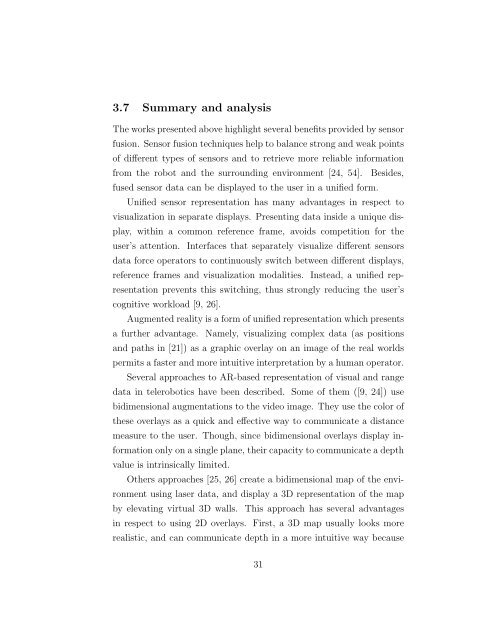Scarica (PDF – 6.19 MB)
Scarica (PDF – 6.19 MB)
Scarica (PDF – 6.19 MB)
You also want an ePaper? Increase the reach of your titles
YUMPU automatically turns print PDFs into web optimized ePapers that Google loves.
3.7 Summary and analysis<br />
The works presented above highlight several benefits provided by sensor<br />
fusion. Sensor fusion techniques help to balance strong and weak points<br />
of different types of sensors and to retrieve more reliable information<br />
from the robot and the surrounding environment [24, 54]. Besides,<br />
fused sensor data can be displayed to the user in a unified form.<br />
Unified sensor representation has many advantages in respect to<br />
visualization in separate displays. Presenting data inside a unique dis-<br />
play, within a common reference frame, avoids competition for the<br />
user’s attention. Interfaces that separately visualize different sensors<br />
data force operators to continuously switch between different displays,<br />
reference frames and visualization modalities. Instead, a unified rep-<br />
resentation prevents this switching, thus strongly reducing the user’s<br />
cognitive workload [9, 26].<br />
Augmented reality is a form of unified representation which presents<br />
a further advantage. Namely, visualizing complex data (as positions<br />
and paths in [21]) as a graphic overlay on an image of the real worlds<br />
permits a faster and more intuitive interpretation by a human operator.<br />
Several approaches to AR-based representation of visual and range<br />
data in telerobotics have been described. Some of them ([9, 24]) use<br />
bidimensional augmentations to the video image. They use the color of<br />
these overlays as a quick and effective way to communicate a distance<br />
measure to the user. Though, since bidimensional overlays display in-<br />
formation only on a single plane, their capacity to communicate a depth<br />
value is intrinsically limited.<br />
Others approaches [25, 26] create a bidimensional map of the envi-<br />
ronment using laser data, and display a 3D representation of the map<br />
by elevating virtual 3D walls. This approach has several advantages<br />
in respect to using 2D overlays. First, a 3D map usually looks more<br />
realistic, and can communicate depth in a more intuitive way because<br />
31




